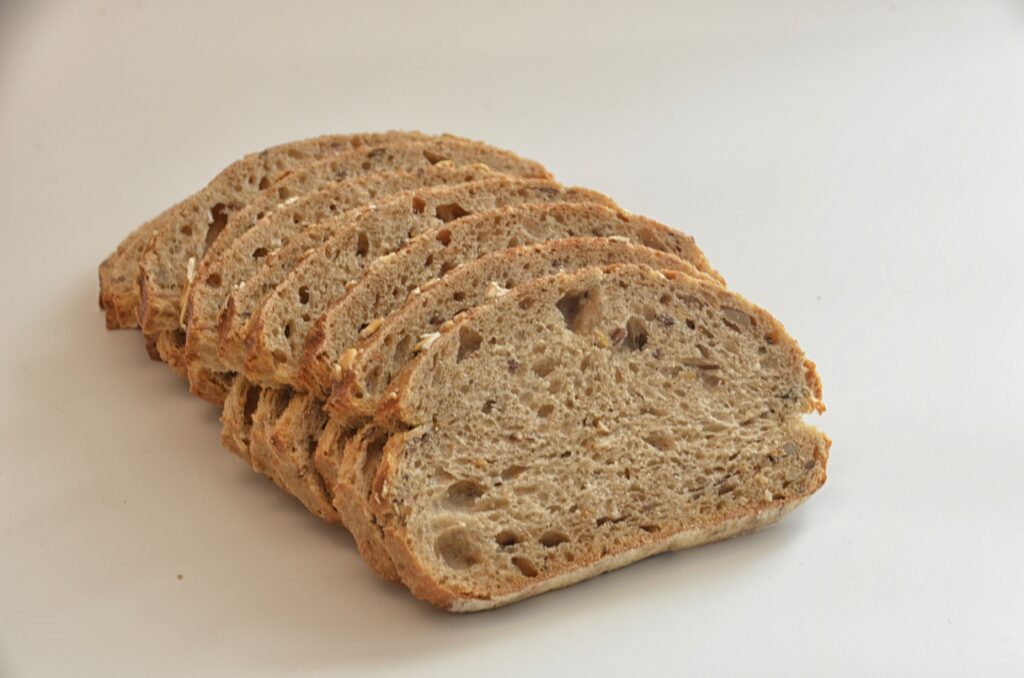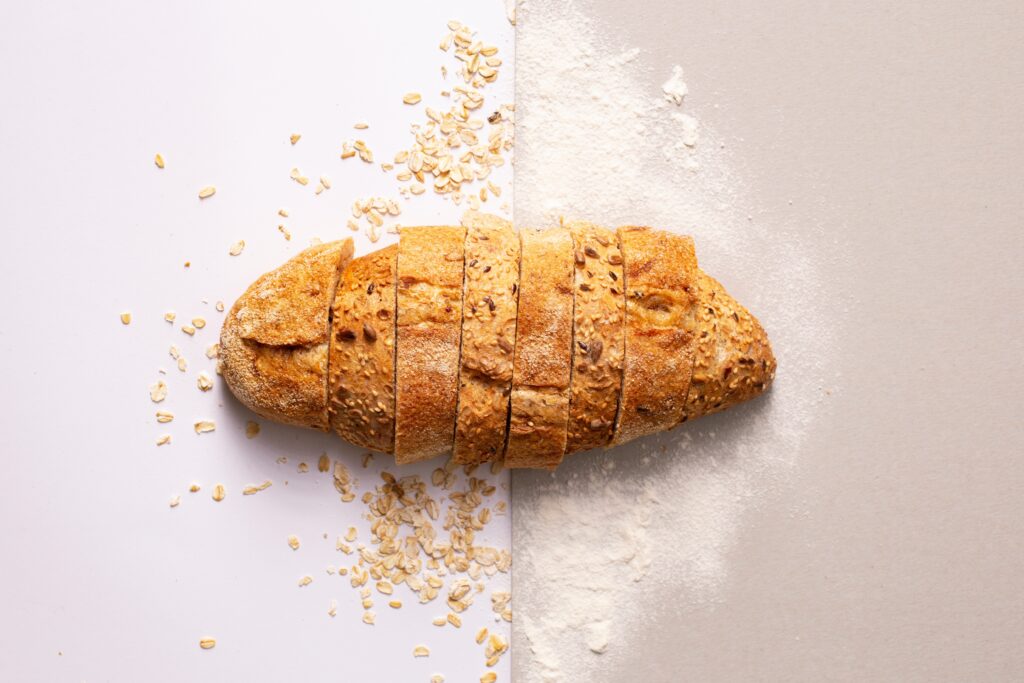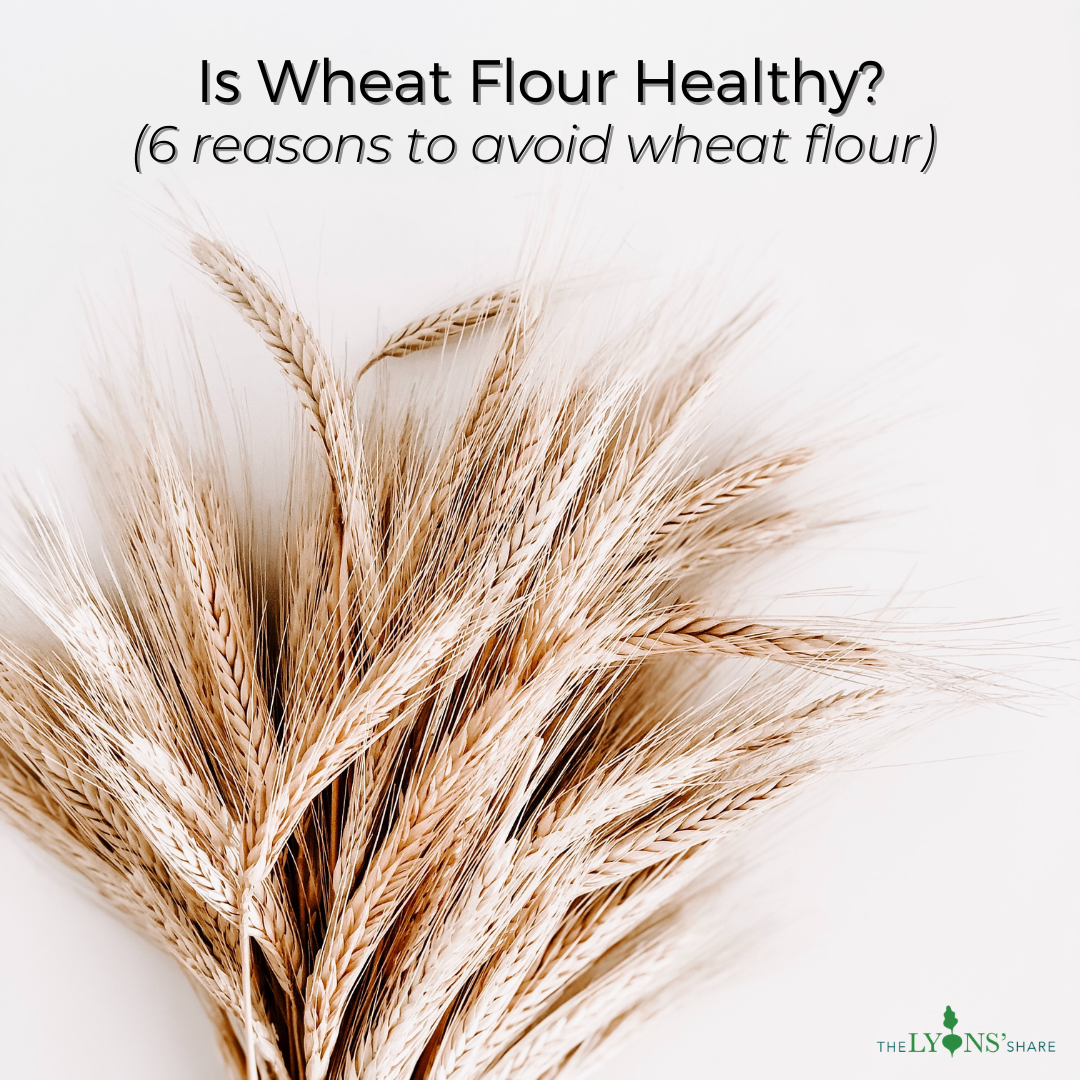Here’s the scene: I’m celebrating a client’s great week, which I always do at the start of the session. There is always something to celebrate, and I like to keep the focus on the positive! Once I finish celebrating, I say, “I noticed you had a sandwich on Tuesday. How did that bread make you feel? Did you notice any energy slumps or brain fog or cravings afterwards?” It’s obvious that I’m hinting that the bread may be causing these things. But the client quickly rushes in to her defense … “oh no, that was wheat bread. Did I not write that down? Sorry!” And then, the conversation starts … is wheat flour healthy?
Wheat bread’s health halo
Unfortunately for us all, wheat flour has gotten a health halo that it doesn’t really deserve. White bread became more popular in the 1920s with the advent of the bread slicing machine, and consumption continued steadily increasing until 2009, when wheat bread consumption surpassed white bread for the first time. At that time, while we realized that many of our health issues were resulting from overconsumption of bread, we blamed it on white bread, and we thought that switching to wheat would be the answer to all of our problems. I distinctly remember my mom diligently switching to Honey Whole Wheat bread (it was in a bright yellow package … even with Google, I can’t find the brand name, but I’m highly confident there was high fructose corn syrup or other unhealthy sweeteners or preservatives in what was marketed to us as healthy!), and we begrudgingly adjusted. After all, it was for our health … right?

Which is healthier: white bread or wheat bread?
Sadly, no. Well, I guess, yes. If given the alternative between white bread and wheat bread, I would still choose wheat bread (unless it was sourdough … see #6 below). Wheat bread does have more fiber and nutrients than white bread, because it uses three parts of the grain (bran, germ, and endosperm), all of which contain nutrients, while white bread uses only the endosperm, which just contains starch. So, wheat bread will technically spike your blood sugar slightly less, keep you slightly fuller, and provide more nutrients than white bread.
But still, it’s not a health food. Here are 6 reasons why I avoid wheat flour, and recommend you avoid or reduce it, too:
- Gluten is inflammatory. Based on the abundance of “gluten-free” products lining supermarket shelves, you probably could have guessed that gluten isn’t great for you. But many people don’t know what gluten actually is. It’s a name for the proteins found in wheat, so yes, all wheat has gluten. It’s impossible to have gluten-free wheat bread (although it is possible to have gluten-free whole grain bread, which is made from grains like oats, rice, sorghum, or millet). And it’s not just a buzzword – it actually causes inflammation in up to 70% of people (this is called “non-celiac gluten sensitivity,” which is different from Celiac disease, an autoimmune condition that impacts 1-3% of people). You can see this post for the potential impacts of the inflammation from gluten – everything from bloating, skin issues, and fatigue to leaky gut, autoimmune conditions, and neurological conditions! At this point, many people ask why their grandparents didn’t worry about gluten. The first reason is probably consumption levels – wheat flour is in everything these days, from cereals to ice cream, salad dressings to soups, protein bars to candy. A little bit of inflammation from a piece of bread every once in a while is a lot different than a little bit of inflammation 15 times per day, rendering your gut lining defenseless against the damage it can cause.The second reason is that modern wheat contains a more inflammatory type of gluten. This study concludes that in “clinical trials … all doubts disappear and diets based on ancient or heritage cultivars [varieties] always showed clear advantages in terms of anti-inflammatory and antioxidant activities” over modern wheat. So, if we had not transformed our wheat (in order to improve processing speed, reactivity to fertilizers and pesticides, GMO farming methods, and more), our response might be blunted, and we might be able to tolerate more wheat.

- Flour made from grains spikes blood sugar significantly. The processing of grains into flour involves grinding them down significantly, making them quicker to digest (sounds like a good thing, but it’s not! It means the sugar can hit your bloodstream almost immediately, causing a spike instead of a slow-release “hump”). In fact, many studies show that the blood sugar impact of processed whole wheat bread is worse than the spike for an equivalent amount of table sugar! The impact depends on the person (see this post for how foods impact my personal blood sugar, and more insights into why blood sugar is important), but a general metric for how detrimental a food is on blood sugar is glycemic index, and sucrose (table sugar) has a GI of 65, which is better than whole wheat bread’s 74. Note that nuts and legumes ground into flour do not have as detrimental of a blood sugar impact, which is one reason that almond flour cookies or chickpea pasta are healthier than the traditional wheat flour variety.
- Wheat flour is grown and commercially modified in unhealthy ways. Many of my clients who go to Europe end up indulging in pastries or pastas made with wheat flour and feel fine … then come back to the US, do the same, and feel bloated and lethargic. This may be because of the differences in processing of US-made wheat. According to the book “Food Fix”, wheat flour is “sprayed with toxic herbicide glyphosate right before harvest, then preserved with calcium propionate, which has been linked to behavioral issues, headaches, and stomach inflammation.” Glyphosate (the pesticide in “Roundup”) has been directly linked to increased gluten sensitivity, so the very thing we’re putting on our wheat is causing us more issues with it! While our wheat isn’t technically a GMO (genetically modified organism), it has been hybridized to be shorter, darker, and higher yielding, and these hybridizations can make the wheat less healthy for us as consumers.
- Other options, like coconut flour or almond meal, have more nutrients. While wheat flour does contain B vitamins and some other nutrients, many alternative flours like coconut and almond, have great health properties that are absent in wheat flour. They’re richer in healthy fats and proteins and lower in carbohydrates than wheat flour, and many have added benefits like higher omega-3 content, high vitamin E, and higher magnesium. If you ever want to really dive into the nutritional differences of many types of flours (even including broccoli flour and cauliflower flour, which I’ve never tried!), check out this study. Here’s a guide to some common substitutes for baking.

- It’s high in phytic acid. Phytic acid is called an “anti-nutrient” because it inhibits the absorption of minerals like iron, zinc, and calcium. All grains, seeds, nuts, and legumes have some phytic acid, but it is often neutralized in cooking. For example, if you soak beans overnight and cook them in a pressure cooker, like people traditionally did, the phytic acid is neutralized. Same with wheat – and the soaking and fermentation process that used to be common in bread would have neutralized this harm as well. But today, we very rarely soak or sprout our grains, and the phytic acid can be detrimental if consumed in high quantities.
- Most things that contain wheat flour are already unhealthy. Here’s the bummer – most things that contain wheat flour, like breads, cookies, pastas, and cakes, are not health foods to begin with. This (nor any of the above) does not mean I think you should never have wheat flour. All things in moderation, if they work for your body. But choosing to limit wheat flour can help make it easier to choose mostly healthy foods. If a dressing has wheat flour in it, it probably also has sugar, preservatives, and other things that pull it very far away from how we’d think of a healthy dressing: maybe some healthy oil, lemon juice, vinegar, garlic, and spices. If you’re looking at a new snack food and it contains wheat flour, it’s likely so processed that you’d be better off choosing some berries and nuts or veggies and hummus. And if, every once in a while, you want to dive into that cupcake with wheat flour, I say go for it – fully recognizing that this is a choice you’re making for your emotional health and not your physical health. And that’s OK every once in a while, too!
If you want more information on avoiding wheat flour, this post gives a bunch of practical tips on how to go gluten-free, and this free download gives a bunch of my gluten-free favorites! Enjoy!
Now it’s your turn … What products do you have in your pantry or fridge right now that have wheat flour in them? What can you substitute instead?


Great post! I completely agree with you on the negative effects of wheat flour on our health. As someone who has struggled with digestive issues for years, I can attest to the fact that cutting back on wheat has made a huge difference in my overall health. It’s amazing how much processed foods contain wheat flour and how it can sneak into our diets in unexpected ways. Thank you for shedding light on this important topic!
I’m glad to see that there are many reasons to avoid wheat flour! I’ve been avoiding it for a while now because I know that it’s not good for me. Thanks for the article!
What is your stance on grains? Even ones considered to be “healthy” like brown rice? The book “Grain Brain” is pretty persuasive of the fact that our bodies only need carbs from fruit and veggies. What’s your stance?
Hi Sadie! It depends on a lot of factors – the person’s metabolism, genetics, starting place, goals, sources of other carbohydrates. I personally get my carbs from mostly vegetables, a bit of fruit, and some chocolate :), but I have many clients who do great with grains in moderation!
I thought your comment about clients who travel to Europe was fascinating. I developed a few food sensitivities that didn’t show up nearly as much when we lived in Switzerland for 6 months, and it made me think a lot about what they abs we are doing in our food production systems.
Thanks for your thoughtful, thorough approach to these questions!
Of course, Una! Thank you for reading!